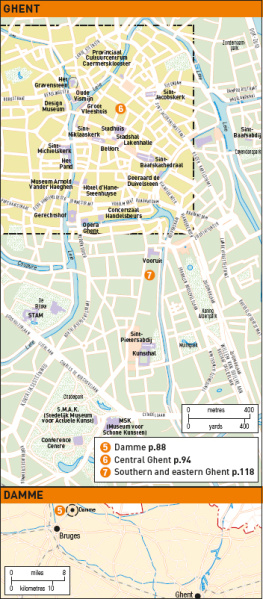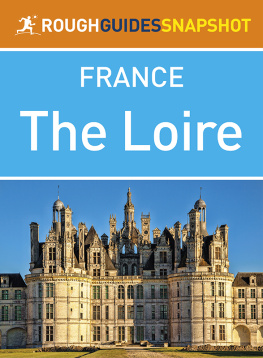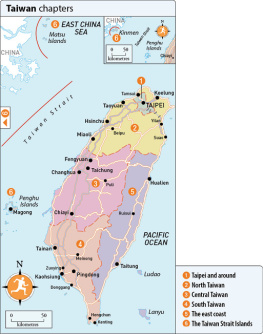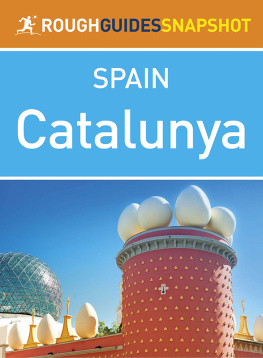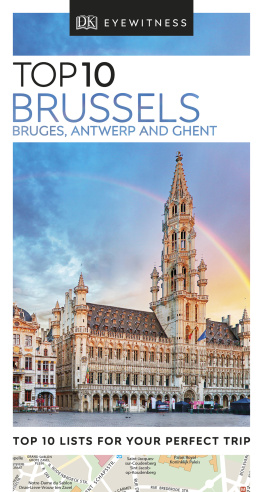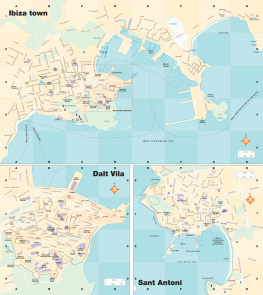BRUGES & GHENT
Passing through Bruges in 1820, William Wordsworth declared that this was where he discovered a deeper peace than in deserts found. Indeed, Wordsworth was one of the first Victorians to fall in love with a city, whose charms continue to enthral its many visitors: Brugess slender canals are flanked by an enchanting ensemble of ancient buildings, punctuated with a string of excellent museums, principally the Groeninge Museum with its world-class collection of early Flemish paintings. Neighbouring Ghent boasts its share of handsome medieval buildings too, and also possesses one of the artistic wonders of the medieval world: the Adoration of the Mystic Lamb altarpiece by Jan van Eyck. Nonetheless, the atmosphere here is markedly different from that in Bruges: the tourist industry supplements but does not dominate the local economy and Ghent is first and foremost a vibrant Flemish city.
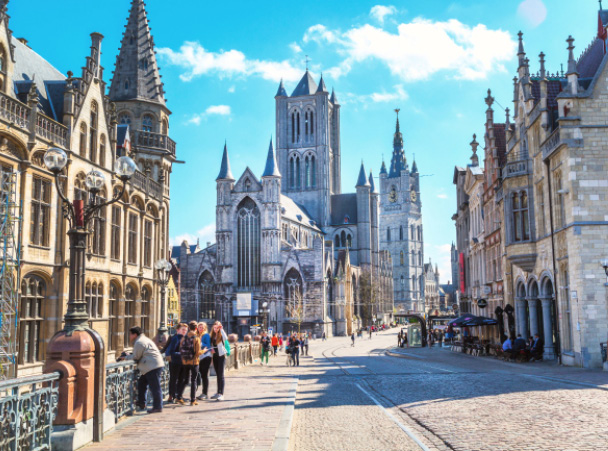
Ghents beautiful old town
Shutterstock
For the modern palate, Brugess blend of antique architectural styles, from tiny brick cottages to gracious Classical mansions, is a welcome relief and retreat. It certainly brings out the romance in many of its visitors stay here long enough and you cant help but be amazed by the number of couples wandering its canals hand-in-hand, cheek-to-cheek. Neither does it matter much that a large part of Bruges is not quite what it seems: many buildings have been carefully constructed to resemble their medieval predecessors. Bruges has spent time and money preserving its image, rendering almost everything thats new in various versions of medieval style, and the result is one of Europes most beautiful city centres. Ghent, on the other hand, is a vital, bustling metropolis whose booming restaurant and bar scene wends its way across a charming cityscape, comprising a network of narrow canals overseen by dozens of antique red-brick houses. If Bruges is a tourist industry with a town attached, Ghent is the reverse a proudly Flemish city which, with a population of around 250,000, is now Belgiums third-largest conurbation.
Bruges and Ghent share a similar history. Both prospered as lynchpins of the cloth trade, turning high-quality English wool into clothing that was exported all over the world. It was an immensely profitable business and one that made Bruges, in particular, a focus of international trade. Through the citys harbours, Flemish cloth was exchanged for hogs from Denmark, spices from Venice, hides from Ireland, wax from Russia and furs from Bulgaria. However, despite (or perhaps because of) this lucrative state of affairs, Bruges and Ghent were dogged by war. The weavers and merchants of both cities were dependent on the goodwill of the kings of England for their wool supply, but their feudal overlords, the counts of Flanders and their successors the dukes of Burgundy, were vassals of the rival king of France. Consequently, whenever France and England were at war which was often both cities found themselves in a precarious position.

A guild house in Ghent
Shutterstock
When to visit
Bruges and Ghent are all-year destinations. Both cities enjoy a fairly standard temperate climate, with warm, if mild, summers and cold winters, without much snow. The warmest months are usually June, July and August (averaging 18C); the coldest, December and January (averaging 2C), when short daylight hours and weak sunlight can make the weather seem colder (and wetter) than it actually is. Rain is always a possibility, even in summer, which actually has more rainfall than either autumn or winter. Warm days in April, May and early June, when the light has the clarity of springtime, are especially appealing, especially in Bruges, before the tourists of summertime arrive in full force. If youre planning a short visit, its worth noting that many of the cities museums are closed on Mondays.
Whats new
In the past few years, Ghent has emerged as a gastronomic pace setter, witnessing the opening of a string of inventive, much-vaunted restaurants , has made sterling efforts to open itself to casual visitors and now offers an enjoyable programme of guided tours.
The Habsburgs swallowed Flanders including Bruges and Ghent into their empire in 1482, and the sour relations that existed with the new rulers led to the decline of the two cities. Economically and politically marooned, Bruges was especially hard hit and simply withered away, its houses deserted, its canals empty and its money spirited away by the departing merchants. Some four centuries later, Georges Rodenbachs novel Bruges-la-Morte alerted well-heeled Europeans to the towns aged, quiet charms, and Bruges attracted its first wave of tourists. Many of them especially the British settled here and came to play a leading role in preserving the citys architectural heritage. Ghent, meanwhile, fared rather better, struggling on as a minor port and trading depot until its fortunes were revived by the development of a cotton spinning industry in the early nineteenth century. Within the space of forty years, Ghent was jam-packed with factories producing all manner of industrial goods and, although the city has moved on from its industrial base, it remains economically buoyant and is Belgiums third-largest metropolis with a population of around 250,000.

The Concertgebouw, the main concert hall in Bruges
Jan DHondt / Toerisme Brugge
Where to
Shop
The holy trinity of Belgian shopping is chocolates, beer and lace. There is no shortage of chocolate and beer shops both chain and family-run in Bruges and Ghent, but lace is rather different. In Bruges, lace is sold in shops all around the city, but most of it is only imported, machine-made pieces the only real exception is t Apostelientje. In Ghent there isnt much evidence of lace at all. If youre after international chain stores, youll find plenty of outlets, especially in Ghent. Most are on the three main shopping streets: Langemunt and Veldstraat in Ghent and Noordzandstraat in Bruges.
OUR FAVOURITES: Bruges:
Eat
As you might expect of a major tourist destination, Bruges has many restaurants, but a large number of them are aimed at outsiders, so standards are often patchy, especially around the Markt. That said, the city does possess a good supply of first-rate places to eat. Ghents restaurant scene is arguably more reliable and indeed the city has an enviable reputation for its pace-setting restaurants. They range from Michelin-starred places with an international menu to more local haunts, which characteristically offer traditional Flemish cuisine with a twist.
OUR FAVOURITES: Bruges:
Drink
With every justification, Belgium is famous for its beers and its bars and Bruges and Ghent are no exception. In both cities, the hallmark bars are small and dark affairs. Almost all the best bars have beer menus, with some running to several hundred brews, mostly bottled, but a few on tap. Many bars also sell jenever, which is similar to gin, made from grain spirit and flavoured with juniper berries. There are two main types the young (

